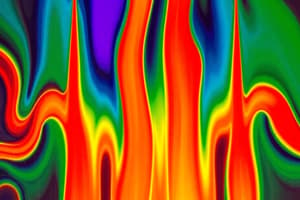Podcast
Questions and Answers
ताप क्या है?
ताप क्या है?
- एक प्रकार की ऊर्जा जिसका स्थानांतरण दाब में अंतर के कारण होता है
- एक प्रकार की ऊर्जा जिसका स्थानांतरण आयतन में अंतर के कारण होता है
- एक प्रकार की ऊर्जा जिसका स्थानांतरण घनत्व में अंतर के कारण होता है
- एक प्रकार की ऊर्जा जिसका स्थानांतरण तापमान में अंतर के कारण होता है (correct)
ताप संचरण के कितने प्रकार हैं?
ताप संचरण के कितने प्रकार हैं?
- तीन (correct)
- पांच
- चार
- दो
जूल (J) क्या है?
जूल (J) क्या है?
- आयतन की इकाई
- दाब की इकाई
- ताप ऊर्जा की इकाई (correct)
- तापमान की इकाई
विशिष्ट ऊष्मा धारिता क्या है?
विशिष्ट ऊष्मा धारिता क्या है?
लेटेंट ऊष्मा क्या है?
लेटेंट ऊष्मा क्या है?
संचालन क्या है?
संचालन क्या है?
थर्मोडायनामिक्स क्या है?
थर्मोडायनामिक्स क्या है?
रेफ्रिजरेशन क्या है?
रेफ्रिजरेशन क्या है?
Study Notes
Definition of Heat
- Heat is a form of energy that is transferred from one body to another due to a difference in temperature.
- It is a measure of the kinetic energy of particles in a substance.
Types of Heat Transfer
- Conduction: Transfer of heat between particles in physical contact with each other.
- Convection: Transfer of heat through the movement of fluids.
- Radiation: Transfer of heat through electromagnetic waves (e.g. light, radio waves).
Heat Transfer Mechanisms
- Heat conduction: Occurs in solids, where heat energy is transferred through direct contact between particles.
- Heat convection: Occurs in fluids, where heat energy is transferred through the movement of fluids.
- Heat radiation: Occurs in all mediums, where heat energy is transferred through electromagnetic waves.
Heat Units
- Joule (J): The SI unit of heat energy.
- Calorie (cal): A unit of heat energy, often used to measure the energy content of food.
- British Thermal Unit (BTU): A unit of heat energy, often used in engineering and HVAC applications.
Heat Properties
- Specific Heat Capacity: The amount of heat energy required to raise the temperature of a substance by 1°C.
- Latent Heat: The heat energy required to change the state of a substance (e.g. melting, boiling).
- Heat Capacity: The amount of heat energy required to raise the temperature of a substance by a given amount.
Heat Transfer Applications
- Thermodynamics: The study of heat, temperature, and energy transfer.
- Refrigeration: The process of transferring heat from a colder body to a hotter body.
- Heat Engines: Devices that convert heat energy into mechanical energy (e.g. internal combustion engines).
ऊष्मा की परिभाषा
- ऊष्मा एक प्रकार की ऊर्जा है जो एक शरीर से दूसरे शरीर में तापमान के अंतर के कारण स्थानांतरित होती है।
- यह एक पदार्थ में कणों की गतिज ऊर्जा का माप है।
ऊष्मा स्थानांतरण के प्रकार
- संचालन: आसन्न कणों के बीच ऊष्मा स्थानांतरण।
- संवहन: द्रवों की गति के माध्यम से ऊष्मा स्थानांतरण।
- विकिरण: विद्युत चुम्बकीय तरंगों (जैसे प्रकाश, रेडियो तरंगे) के माध्यम से ऊष्मा स्थानांतरण।
ऊष्मा स्थानांतरण के механіз्म
- ठोसों में ऊष्मा संचालन: ठोसों में सीधे संपर्क के माध्यम से ऊष्मा स्थानांतरण।
- द्रवों में ऊष्मा संवहन: द्रवों में गति के माध्यम से ऊष्मा स्थानांतरण।
- सभी माध्यमों में ऊष्मा विकिरण: विद्युत चुम्बकीय तरंगों के माध्यम से ऊष्मा स्थानांतरण।
ऊष्मा इकाइयां
- जूल (J): ऊष्मा ऊर्जा की एसआई इकाई।
- कैलोरी (cal): ऊष्मा ऊर्जा की इकाई, अक्सर खाद्य की ऊर्जा सामग्री को मापने के लिए प्रयोग की जाती है।
- ब्रिटिश थर्मल यूनिट (BTU): ऊष्मा ऊर्जा की इकाई, अक्सर इंजीनियरिंग और एचवीएसी एप्लीकेशन में प्रयोग की जाती है।
ऊष्मा गुण
- विशिष्ट ऊष्मा क्षमता: एक पदार्थ के तापमान को 1°C बढ़ाने के लिए आवश्यक ऊष्मा ऊर्जा।
- लेटेंट ऊष्मा: पदार्थ की अवस्था को बदलने के लिए आवश्यक ऊष्मा ऊर्जा (जैसे पिघलना, उबलना)।
- ऊष्मा क्षमता: एक पदार्थ के तापमान को दिए गए मात्रा से बढ़ाने के लिए आवश्यक ऊष्मा ऊर्जा।
ऊष्मा स्थानांतरण अनुप्रयोग
- थर्मोडायनामिक्स: ऊष्मा, तापमान और ऊर्जा स्थानांतरण का अध्ययन।
- रेफ्रिजरेशन: एक ठंडे शरीर से गरम शरीर में ऊष्मा स्थानांतरण की प्रक्रिया।
- ऊष्मा इंजन: ऊष्मा ऊर्जा को यांत्रिक ऊर्जा में परिवर्तित करने वाले उपकरण (जैसे इंटरनल कंबशन इंजन)।
Studying That Suits You
Use AI to generate personalized quizzes and flashcards to suit your learning preferences.
Description
इस क्विज में हीट_energy की परिभाषा और हीट ट्रांसफर के प्रकार के बारे में जानें।_conduction, convection, और radiation जैसे विभिन्न तरीकों से हीट ट्रांसफर होता है।




